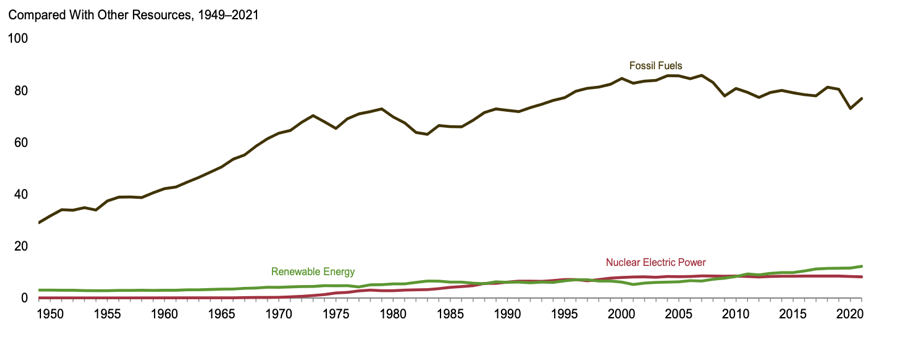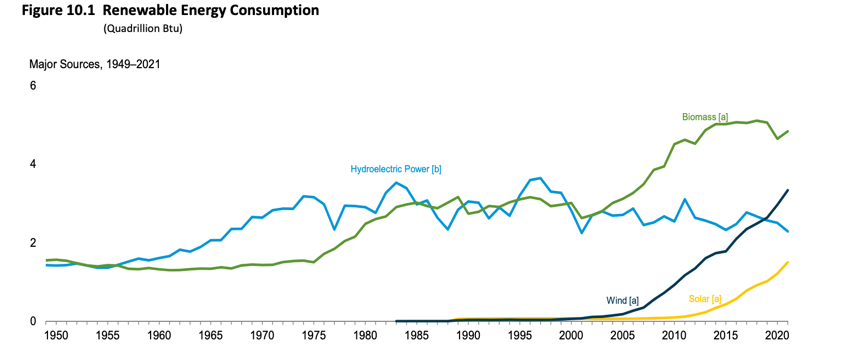 Covering COVID-19 is a daily Poynter briefing of story ideas about the coronavirus and other timely topics for journalists, written by senior faculty Al Tompkins. Sign up here to have it delivered to your inbox every weekday morning.
Covering COVID-19 is a daily Poynter briefing of story ideas about the coronavirus and other timely topics for journalists, written by senior faculty Al Tompkins. Sign up here to have it delivered to your inbox every weekday morning.
On this Earth Day 2022, there is something of a milestone to note. The U.S. Department of Energy says that on March 29, wind turbines generated the second-largest amount of electricity for the country. Natural gas was still the No. 1 by a long shot, but on this one day, wind outproduced coal, nuclear and hydro sources.
The energy department notes that spring often provides the best winds for wind turbines, just as the winter thaw produces river and lake levels that produce a lot of hydropower.
Wind power sometimes surpasses nuclear and sometimes surpasses coal, but this was the first time it topped them both at the same time.
The milestone comes as the Biden administration has made increased wind power installations a central part of its agenda to reduce U.S. carbon emissions by half by the end of the decade. The Interior Department has signed off on a number of offshore wind projects, including most recently the first wind power lease off the Carolinas in late March. The Biden administration has set a goal of leasing 30 gigawatts’ worth of offshore wind power.
I pulled the latest DOE data on renewable electric generation, and it shows a stark reminder that renewable energy, while growing, still provides far fewer national energy needs than fossil fuel sources, mainly natural gas. Fossil fuels provide about 80% of America’s energy. Natural gas provides about a third of America’s electricity.

(U.S. Department of Energy)
But you can see that of all renewable electric sources, wind power is increasing at a faster rate than any other.

(U.S. Department of Energy)
Of all renewal sources, wind provides double the kilowatt-hours of electricity compared to solar. But again, I point you to the first graphic to help you keep in mind that all of these sources combined produce a tenth of the nation’s energy needs every day.

(U.S. Department of Energy)
A multi-year bureaucratic backlog is holding up big renewable projects
Grist, which covers climate issues, says a lot more renewable energy projects could be feeding the electrical grid, but there is a huge and growing backlog to get approved.
This entire period between initial application to the grid and having a functioning utility-scale power plant is called the “interconnection queue,” and right now, it’s jammed up like rush hour traffic. The study found that as of 2021, the average power project was spending 4 years on the queue, compared to just 2.1 years in the decade leading up to 2010. The number of projects withdrawing from the whole process each year seems to be going up, too.
The number of applications is, indeed, mind blowing. If all of the proposed projects that were sitting in the queue at the end of 2021 were built tomorrow, the U.S. would hit Biden’s goal of an 80 percent clean electric grid eight years early, according to the Department of Energy. It’s not just that renewable energy applications have increased relative to fossil fuels. The total amount of electricity capacity tied up in the queue is about three times higher now than it was a decade ago.
That’s important, because tackling climate change doesn’t just require replacing fossil fuels with renewables — we also need to generate a lot more power. Switching to electric vehicles and swapping out gas-fueled home appliances for electric heaters and stoves could increase U.S. demand for electricity by 40 percent by 2050.
States ranked on energy use and energy costs
With winter weather raking millions of Americans again this week, I wondered where people spend the most, per capita, on energy. The Department of Energy keeps that data too, even though it is a little dated.
Earth day: Status of endangered species by state

A Mexican gray wolf is seen at the Endangered Wolf Center Monday, May 20, 2019, in Eureka, Mo. (AP Photo/Jeff Roberson)
On this Earth Day, I wanted to see what is new with endangered species. The global list is beyond depressing.
The U.S. Fish and Wildlife Service has a library of resources to help you get local on the subject of endangered species.
Here are some links to how many and which species …
- are listed in the United States as threatened or endangered?
- are listed in each State?
- are listed in other countries?
- are listed and are under the primary responsibility of the NOAA Fisheries?
- were the first species to be listed?
- are proposed for listing?
- are candidates for listing?
- are proposed species under the primary responsibility of the NOAA Fisheries?
- have been petitioned for listing?
- have critical habitat designated?
- have special rules under section 4(d) to customize the protections of the Endangered Species Act?
- have been removed from the List (delisted) and why?
- have been reclassified (change in status)?
- are proposed for a status change or delisting? (This report includes proposals for new experimental populations, similarity of appearance protection, reclassification to endangered, and reclassification to threatened)
Invasive species, one of the biggest threat to endangered plants and animals
The National Wildlife Federation says that about 42% of threatened or endangered species are at risk due to invasive species.
The Department of Interior says invasive grasses contribute to wildfires:
There is a feedback mechanism between invasive species and fire. For example, in the West, this is primarily a function of fire-tolerant invasive grasses spreading into landscapes which were previously much less prone to burning; where native plants did not provide a continuous bed of fine fuels but non-natives do.
There are so many groups and agencies working on specific problems. Here are some of them:
- Aquatic Nuisance Species Task Force (ANSTF)
- Federal Interagency Committee for the Management of Noxious and Exotic Weeds (FICMNEW)
- The National Invasive Species Council
And there are success stories to highlight, too.
Look at your city’s tree canopy

In this Jan. 29, 2014, file photo, two visitors walk under a canopy of live oak trees in Savannah’s historic downtown. (AP Photo/Stephen B. Morton, File)
In the early days, cynics called people who celebrated Earth Day “tree huggers.” So let’s hug some trees by looking at your city’s tree canopy using MIT’s Treepedia.
Treepedia uses Google Street View photos and an algorithm to count the trees on the streets of 27 cities worldwide. I was surprised to see that Tampa has the most street tree cover at about 36%. There is some debate about that, however, since the U.S. Forest Service estimated New York City’s tree canopy at 39% versus Treepedia’s estimate of 16.6%. Treepedia didn’t count Central Park but looked at trees over city streets.
Take a look at whether your city enforces arbor laws while cities are exploding with new construction. Fresno, California, just announced a plan to plant a thousand trees a year in the city’s highest-need areas. The Fresno Bee reports:
Introduced by Fresno City Council Vice President Tyler Maxwell, the “City of Fresno Tree Policy” would commit the city to plant a minimum of 1,000 drought-tolerant trees on public property each year until 2035 and provide youth jobs in tree maintenance and care, as well as creating a rebate program to incentivize home and business owners to plant more trees.
Research shows that trees play a vital role in keeping neighborhoods cool during heat season, in addition to physical and mental health benefits. Some city neighborhoods, particularly those with fewer trees, see fewer benefits from trees.
An analysis by the nonprofit conservation group American Forests found that whiter, more affluent communities in cities across the country, including Fresno, tend to have more trees, while low-income neighborhoods and communities of color tend to have fewer.
Furthermore, research on the urban heat island effect – areas of the city that are hotter than their surrounding area due to the lack of green space and parks – indicates that people who live in the hottest parts of a city are more likely to be poor.
State ends up with surplus money, will send $850 to each resident
The Maine legislature is about to send 850,000 Mainers checks for $850 after the state found itself awash in federal spending and a robust tax year. The money should hit bank accounts in June, and it does not end there. Gov. Janet Mills signed the bill that also provides $20 million to pay for two years of free community college for class of 2020-2023 high school grads in Maine. And older and low-income Mainers will get property tax relief.
We’ll be back Monday with a new edition of Covering COVID-19. Are you subscribed? Sign up here to get it delivered right to your inbox.







